The world's largest helicopter
 Bashny.Net
Bashny.Net
Original taken from alexcheban in the world's largest helicopter
29 ph

The helicopter flew over a blazing Chernobyl reactor in the hot spots of the world as part of UN peacekeeping missions. It can carry loads up to 20 tons, the flight range - 2000 km. The diameter of the rotor is equal to wingspan of a Boeing 737. It has two motor horsepower of 11 000 power each. This Mi-26 - the largest helicopter in the world! Airline "UTair" operates the world's largest in size and capacity of the helicopter fleet. The park has 352 helicopter companies, 25 of which - is the Mi-26.
I already wrote about the world's largest airplane before, and in this report I will tell about the history of the world's largest helicopter, as well as two interesting a movie about the Mi-26.

Mi-26 - Soviet multipurpose transport helicopter. It is the world's largest serial transport helicopter.
Developer - Mil. The first flight was made December 14, 1977. Commercially produced by the Rostov Helicopter Plant. Total produced more than 310 machines. The release continues.
Mi-26 UTair livery UN Surgut:
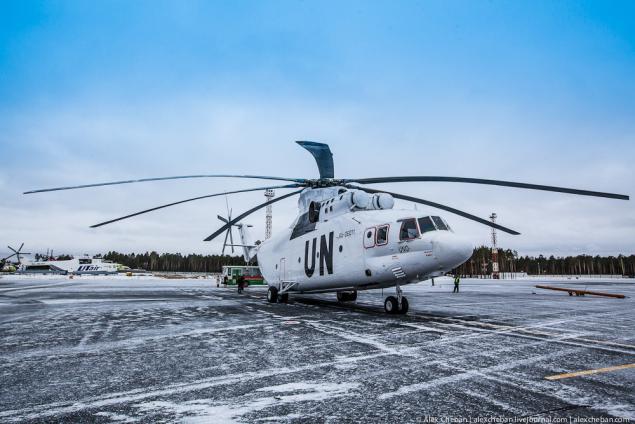
Project heavy helicopter assigned a new designation Mi-26 or "product 90". Having received a positive opinion from the Scientific Research Institute of MAP, the team '' MVZ. ML Mile '' in August 1971, began to develop a pilot project, which was completed in three months. By this time the military customer has made changes to the technical requirements for the helicopter - increased the maximum payload weight from 15 to 18 tons. The project was redesigned. The Mi-26, like its predecessor, the Mi-6, designed for transportation of various types of military equipment, delivering ammunition, food, equipment and other tangible assets, vnutrifrontovyh rendition divisions of troops with combat equipment and weapons, the evacuation of the sick and wounded and, in some cases for tactical landings.

Mi-26 is the first domestic helicopter of the new third generation. These rotorcraft were developed in the late 60's - early 70-ies. Many foreign companies, and differs from its predecessors improved technical and economic indicators, primarily transport efficiency. But the parameters of the Mi-26 were significantly superior to both domestic and foreign indices helicopter with the cargo cabin. Load ratio was 50% (instead of 34% for MI-6), fuel efficiency - 0, 62 kg / (t * km). Almost at the same geometric dimensions as that of MI-6, the new machine has twice the payload and significantly improved performance characteristics. The increase in carrying capacity by half almost no effect on the take-off weight of the helicopter.
Cab

Scientific and Technical Council approved the preliminary design of MAP Mi-26 in December 1971 Design air giant implied holding a large volume of research, development and technological work, and the development of new equipment.
In 1972, '' MVZ. ML Mile '' has received positive conclusion of the institutions of the aviation industry and the customer. Of the two proposals submitted by the Air Force Mi-26 and rotorcraft development Ukhtomskogo Helicopters - Milevska chose the military machine. An important step in the design of the helicopter was well-written specification. The customer originally requested installation on a helicopter wheel drive, heavy weapons, seal the cargo compartment, ensure that the engines in the automotive fuels, and similar improvements, entailing a significant weighting structure. Engineers have found a reasonable compromise - secondary demands were rejected, and most importantly - implemented. The result has been made the new cabin layout, allowing the crew to increase from four to five people; height of the cargo compartment, in contrast to the initial design was the same throughout its length. Refinement has undergone construction and some other parts of the helicopter.
Another cabin
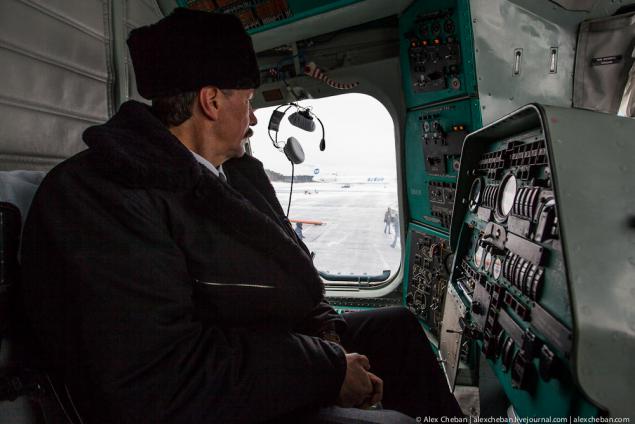
In 1974, the appearance of a heavy Mi-26 is almost fully formed. He had a classic for the transport helicopters Mil layout: almost all of the power plant located on the truck cab; handed forward with respect to the main engines and gear located in the forward part of the cabin crew equilibrated tailpiece. In the design of the helicopter fuselage first payment was made by specifying a surface of the curve of the second order, so an all-metal semi-monocoque fuselage of the Mi-26 received its characteristic aerodynamically shaped 'dolphin-"form. Its design was originally envisaged to use a panel assembly and kleesvarnye frame joints.
Full view

The forward fuselage of the Mi-26 was a cabin crew from the commander (pilot left), the right pilot, navigator and flight engineer, as well as the cabin for four people accompanying the goods, and the fifth member of the crew - mechanic. On the cabin side-hatches were provided blisters emergency escape helicopters and armor plates.
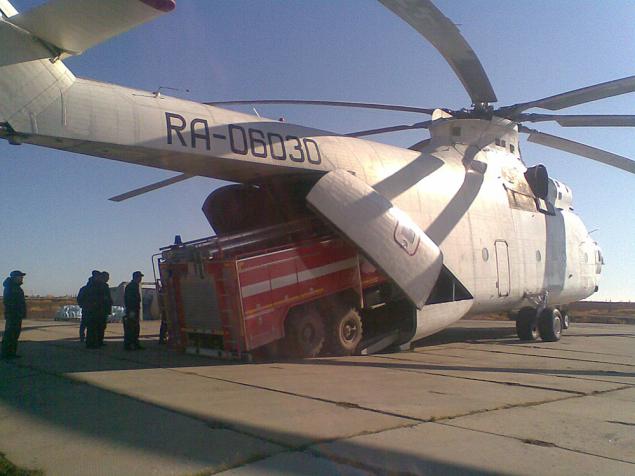
The central part of the fuselage held the spacious cargo compartment with the rear compartment, passing in the tail boom. Cabin length - 12, 1 m (with ladder - 15m), width - 3, 2 m, and the height varying from 2, 95 to 3, 17 m. As confirmed by mock trial, dimensions cockpit allows you to carry all kinds of promising military vehicles weighing up to 20 tons, designed to equip mechanized infantry division, such as infantry fighting vehicle, self-propelled howitzer, armored reconnaissance vehicle, etc. Loading equipment was carried out under its own power through the cargo hatch in the rear fuselage, equipped with two pull-down side flaps and lowered a ladder to podtrapnikami. Management gangway and flaps were hydraulic.
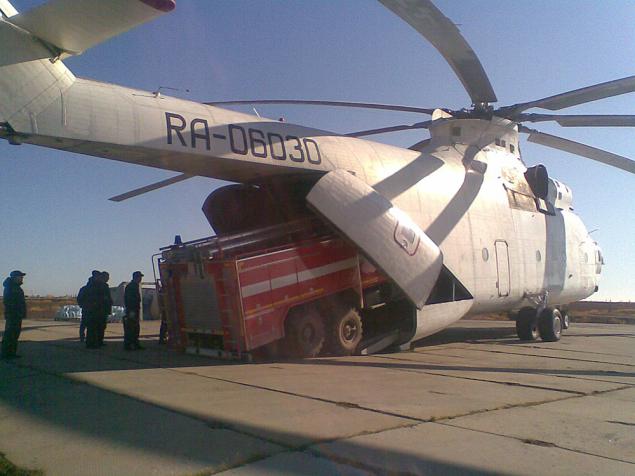
Unloading

Load of passengers or light cargo could be carried out, in addition, three entrance stairs on the sides of the fuselage. In landing variant of the Mi-26 was carrying 82 soldiers or 68 paratroopers. Special equipment allowed for a few hours to turn in a helicopter ambulance to transport 60 wounded on stretchers and three accompanying medical staff. Oversized loads weighing up to 20 tonnes can be transported on external sling. Its units were located in the construction of the power of sex, so that did not require the dismantling of the system for the carriage of cargo inside the fuselage. Rear cargo door fuselage smoothly into the tail boom with a profiled end-keel beam and stabilizer.

compartment

everything in its place

Under the cargo floor of the fuselage were placed eight main fuel tanks with a total capacity of 12,000 liters. The ferry in the cargo version of the Mi-26 could be installed four additional tanks with total capacity of 14,800 liters. On top, above the truck cab positioned engine compartment, the main gearbox and the two supplies of fuel tanks. At the entrance to the air intakes of engines were installed mushroom dust device. Consumables fuel tanks and engines were protected by armor.
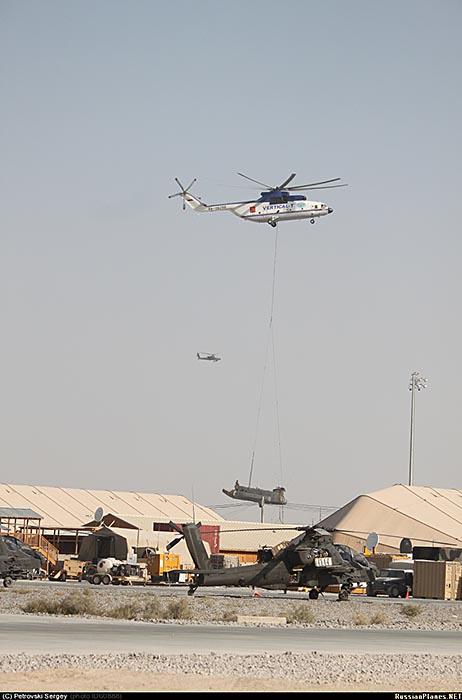
The primary objective in the design of the Mi-26, as well as all other helicopters, was the creation of the modern rotor having a low weight and high aerodynamic performance and durability. For the first time in the history of heavy-duty helicopter rotor Mi-26 was created vosmilopastnym. In order to collect a screw sleeve bushings had to make removable. Fixing of the blades to the hub was a conventional, through three joints, but the design of the hinge axis engineers' Mil. Mil '' entered torsion perceiving centrifugal loads. A number of hinge joints are made using metal-PTFE bearings. The vertical joints were equipped with spring-hydraulic dampers. To reduce the weight of the rotor head in its construction instead of the titanium steel was used. All this has created vosmilopastnoy rotor thrust with a 30% increase and a mass of 2 tons less than the five-blade rotor Mi-6.
Mi-26 Chassis - tricycle, including the front and the two main supports, a two-chamber amortization racks. By the end beam has been installed retractable tail wheel. For ease of loading and unloading the main landing gear were equipped with the system change in clearance.
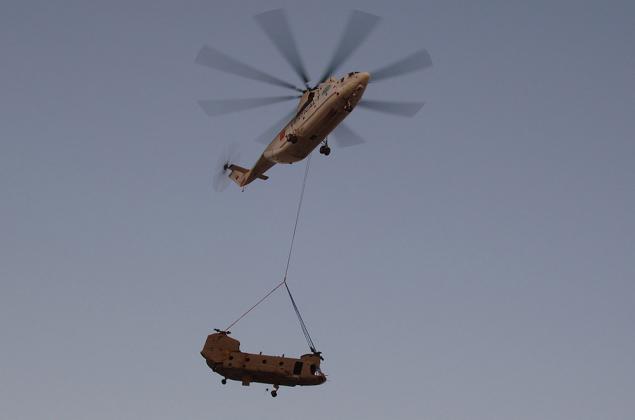
Three heroes:

To carry the carcass of the aircraft? Easy !:

Deliveries of the Mi-26 in individual transport and combat aircraft Ground Forces regiments, the regiments and squadrons of border troops began in 1983. After several years of refinement, they become trusted and loved ones in the armed forces vehicles. Combat use of the helicopter began in Afghanistan. Is part of the 23th Regiment of frontier troops used helicopters for transportation of goods, delivery of reinforcements and evacuate the wounded. Combat losses were not. Attended by Mi-26 and almost all armed conflicts in the Caucasus, including the two "Chechen" wars. In particular, it is the Mi-26 carried out prompt delivery of troops and their redeployment during the fighting in Dagestan in 1999. In addition to military aviation and border troops Mi-26 were received at the time and in the air unit the Russian Interior Ministry. Everywhere helicopter showed himself extremely reliable and often irreplaceable machine.
We have been used Mi-26 fighting fires, and natural disasters. In 1986, helicopters were used in the aftermath of the Chernobyl accident.
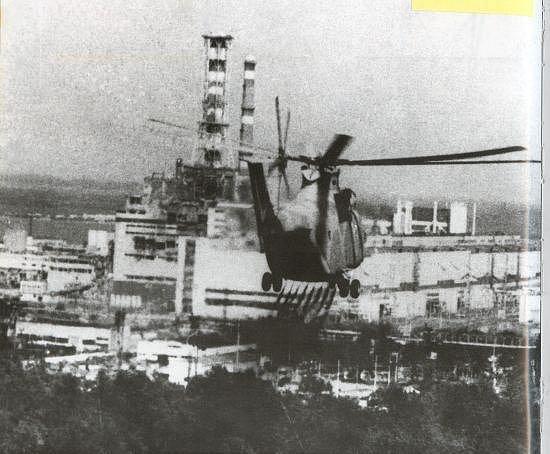
Chernobyl
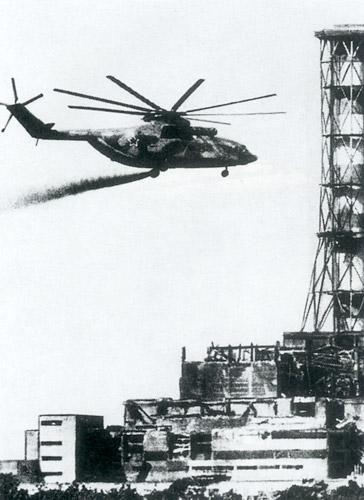
Quenching:

Fallen giants:
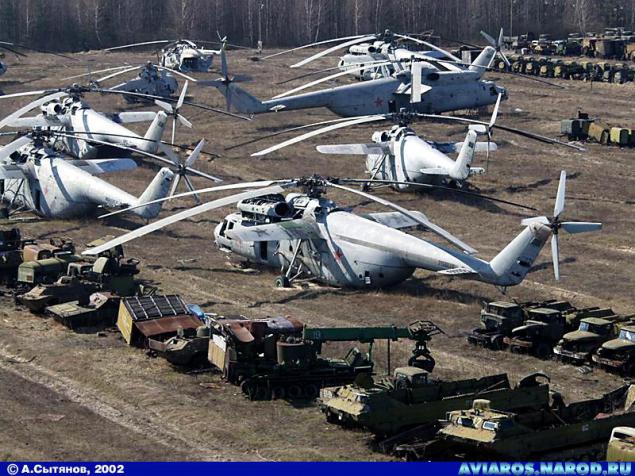
The Mi-26 Aeroflot began arriving in 1986 received their first Tyumen airline. It was during the development of oil and gas fields of Western Siberia is especially useful Rostov, heavy-duty. Especially in demand were unique crane-mounting capability of the machine. Only it can be transported and installed on-site operation of loads weighing up to 20 tons.
It happened to the Russian and Ukrainian Mi-26 to participate in UN peacekeeping missions. They worked on the territory of the former Yugoslavia, Somalia, Cambodia, Indonesia, etc.

Due to the unique Rostov-duty, heavy-duty high demand abroad. There they operated the last ten years as the domestic airlines, and as part of foreign hired helicopters to rent or lease. Mi-26T is performed in Germany and other European countries with heavy oversized cargo transportation, construction and assembly works in the construction of power lines, antenna mast construction, reconstruction and construction of industrial facilities, and urban fighting forest fires.
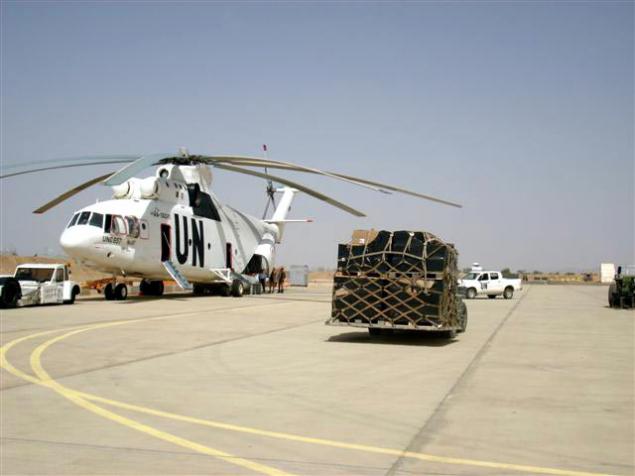
Interesting facts:
- September 27, 1996 was used for the construction of a large formation which was later entered in the Guinness Book of Records. During this event has been set another record, the Mi-26 lifted to a height of 6,500 meters 224 parachutist.
- We used to evacuate two helicopters CH-47 "Chinook" US forces in Afghanistan, the evacuation cost $ 650 000.
- Used to transport Tu-134 of Pulkovo airport to the landfill near MOE Fishing neighborhoods in St. Petersburg.
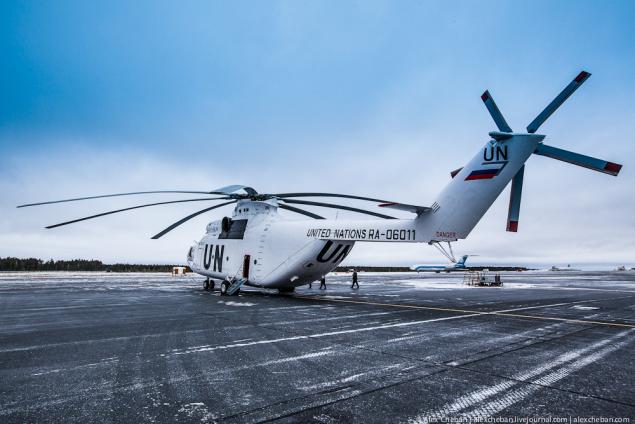
Ass:

Closer:
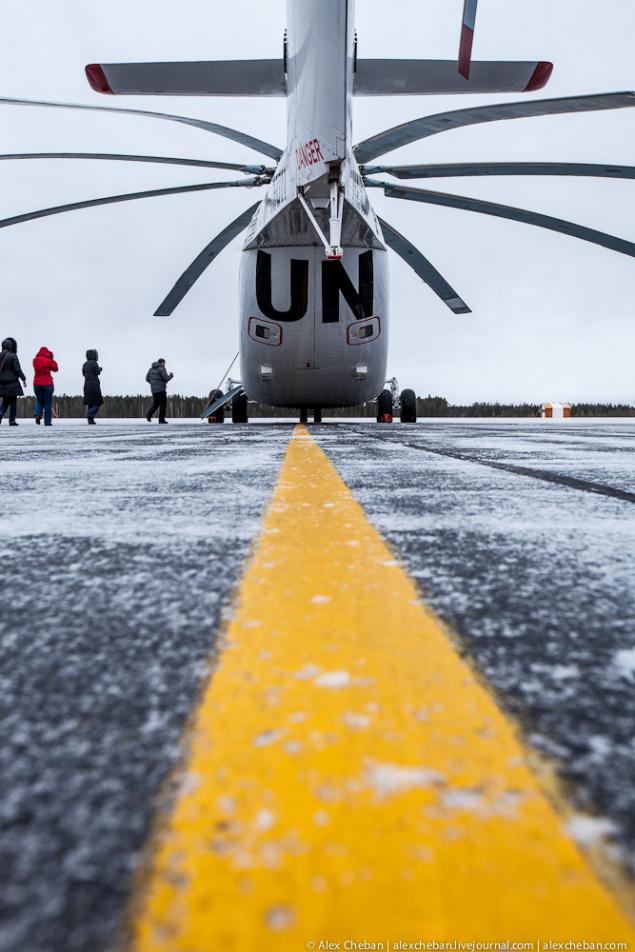
One of the pilots:
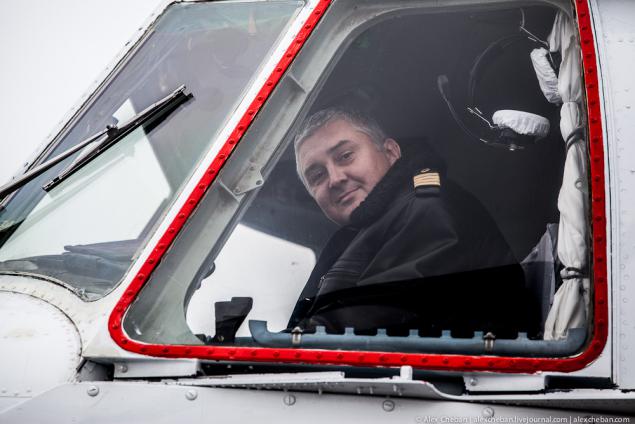
Anfas:
Posted in [mergetime] 1352269808 [/ mergetime]
And two interesting a movie:
1. The plot Discovery Channel about the transport of heavy loads in Canada:
2. The film "Rescue lifeguard" about the transportation of the fuselage of the Mi-26 from Kazakhstan to Novosibirsk Aircraft Repair Plant for further recovery:
I have everything, thank you for your attention!

Source:
29 ph

The helicopter flew over a blazing Chernobyl reactor in the hot spots of the world as part of UN peacekeeping missions. It can carry loads up to 20 tons, the flight range - 2000 km. The diameter of the rotor is equal to wingspan of a Boeing 737. It has two motor horsepower of 11 000 power each. This Mi-26 - the largest helicopter in the world! Airline "UTair" operates the world's largest in size and capacity of the helicopter fleet. The park has 352 helicopter companies, 25 of which - is the Mi-26.
I already wrote about the world's largest airplane before, and in this report I will tell about the history of the world's largest helicopter, as well as two interesting a movie about the Mi-26.

Mi-26 - Soviet multipurpose transport helicopter. It is the world's largest serial transport helicopter.
Developer - Mil. The first flight was made December 14, 1977. Commercially produced by the Rostov Helicopter Plant. Total produced more than 310 machines. The release continues.
Mi-26 UTair livery UN Surgut:

Project heavy helicopter assigned a new designation Mi-26 or "product 90". Having received a positive opinion from the Scientific Research Institute of MAP, the team '' MVZ. ML Mile '' in August 1971, began to develop a pilot project, which was completed in three months. By this time the military customer has made changes to the technical requirements for the helicopter - increased the maximum payload weight from 15 to 18 tons. The project was redesigned. The Mi-26, like its predecessor, the Mi-6, designed for transportation of various types of military equipment, delivering ammunition, food, equipment and other tangible assets, vnutrifrontovyh rendition divisions of troops with combat equipment and weapons, the evacuation of the sick and wounded and, in some cases for tactical landings.

Mi-26 is the first domestic helicopter of the new third generation. These rotorcraft were developed in the late 60's - early 70-ies. Many foreign companies, and differs from its predecessors improved technical and economic indicators, primarily transport efficiency. But the parameters of the Mi-26 were significantly superior to both domestic and foreign indices helicopter with the cargo cabin. Load ratio was 50% (instead of 34% for MI-6), fuel efficiency - 0, 62 kg / (t * km). Almost at the same geometric dimensions as that of MI-6, the new machine has twice the payload and significantly improved performance characteristics. The increase in carrying capacity by half almost no effect on the take-off weight of the helicopter.
Cab

Scientific and Technical Council approved the preliminary design of MAP Mi-26 in December 1971 Design air giant implied holding a large volume of research, development and technological work, and the development of new equipment.
In 1972, '' MVZ. ML Mile '' has received positive conclusion of the institutions of the aviation industry and the customer. Of the two proposals submitted by the Air Force Mi-26 and rotorcraft development Ukhtomskogo Helicopters - Milevska chose the military machine. An important step in the design of the helicopter was well-written specification. The customer originally requested installation on a helicopter wheel drive, heavy weapons, seal the cargo compartment, ensure that the engines in the automotive fuels, and similar improvements, entailing a significant weighting structure. Engineers have found a reasonable compromise - secondary demands were rejected, and most importantly - implemented. The result has been made the new cabin layout, allowing the crew to increase from four to five people; height of the cargo compartment, in contrast to the initial design was the same throughout its length. Refinement has undergone construction and some other parts of the helicopter.
Another cabin

In 1974, the appearance of a heavy Mi-26 is almost fully formed. He had a classic for the transport helicopters Mil layout: almost all of the power plant located on the truck cab; handed forward with respect to the main engines and gear located in the forward part of the cabin crew equilibrated tailpiece. In the design of the helicopter fuselage first payment was made by specifying a surface of the curve of the second order, so an all-metal semi-monocoque fuselage of the Mi-26 received its characteristic aerodynamically shaped 'dolphin-"form. Its design was originally envisaged to use a panel assembly and kleesvarnye frame joints.
Full view

The forward fuselage of the Mi-26 was a cabin crew from the commander (pilot left), the right pilot, navigator and flight engineer, as well as the cabin for four people accompanying the goods, and the fifth member of the crew - mechanic. On the cabin side-hatches were provided blisters emergency escape helicopters and armor plates.

The central part of the fuselage held the spacious cargo compartment with the rear compartment, passing in the tail boom. Cabin length - 12, 1 m (with ladder - 15m), width - 3, 2 m, and the height varying from 2, 95 to 3, 17 m. As confirmed by mock trial, dimensions cockpit allows you to carry all kinds of promising military vehicles weighing up to 20 tons, designed to equip mechanized infantry division, such as infantry fighting vehicle, self-propelled howitzer, armored reconnaissance vehicle, etc. Loading equipment was carried out under its own power through the cargo hatch in the rear fuselage, equipped with two pull-down side flaps and lowered a ladder to podtrapnikami. Management gangway and flaps were hydraulic.

Unloading

Load of passengers or light cargo could be carried out, in addition, three entrance stairs on the sides of the fuselage. In landing variant of the Mi-26 was carrying 82 soldiers or 68 paratroopers. Special equipment allowed for a few hours to turn in a helicopter ambulance to transport 60 wounded on stretchers and three accompanying medical staff. Oversized loads weighing up to 20 tonnes can be transported on external sling. Its units were located in the construction of the power of sex, so that did not require the dismantling of the system for the carriage of cargo inside the fuselage. Rear cargo door fuselage smoothly into the tail boom with a profiled end-keel beam and stabilizer.

compartment

everything in its place

Under the cargo floor of the fuselage were placed eight main fuel tanks with a total capacity of 12,000 liters. The ferry in the cargo version of the Mi-26 could be installed four additional tanks with total capacity of 14,800 liters. On top, above the truck cab positioned engine compartment, the main gearbox and the two supplies of fuel tanks. At the entrance to the air intakes of engines were installed mushroom dust device. Consumables fuel tanks and engines were protected by armor.

The primary objective in the design of the Mi-26, as well as all other helicopters, was the creation of the modern rotor having a low weight and high aerodynamic performance and durability. For the first time in the history of heavy-duty helicopter rotor Mi-26 was created vosmilopastnym. In order to collect a screw sleeve bushings had to make removable. Fixing of the blades to the hub was a conventional, through three joints, but the design of the hinge axis engineers' Mil. Mil '' entered torsion perceiving centrifugal loads. A number of hinge joints are made using metal-PTFE bearings. The vertical joints were equipped with spring-hydraulic dampers. To reduce the weight of the rotor head in its construction instead of the titanium steel was used. All this has created vosmilopastnoy rotor thrust with a 30% increase and a mass of 2 tons less than the five-blade rotor Mi-6.
Mi-26 Chassis - tricycle, including the front and the two main supports, a two-chamber amortization racks. By the end beam has been installed retractable tail wheel. For ease of loading and unloading the main landing gear were equipped with the system change in clearance.

Three heroes:

To carry the carcass of the aircraft? Easy !:

Deliveries of the Mi-26 in individual transport and combat aircraft Ground Forces regiments, the regiments and squadrons of border troops began in 1983. After several years of refinement, they become trusted and loved ones in the armed forces vehicles. Combat use of the helicopter began in Afghanistan. Is part of the 23th Regiment of frontier troops used helicopters for transportation of goods, delivery of reinforcements and evacuate the wounded. Combat losses were not. Attended by Mi-26 and almost all armed conflicts in the Caucasus, including the two "Chechen" wars. In particular, it is the Mi-26 carried out prompt delivery of troops and their redeployment during the fighting in Dagestan in 1999. In addition to military aviation and border troops Mi-26 were received at the time and in the air unit the Russian Interior Ministry. Everywhere helicopter showed himself extremely reliable and often irreplaceable machine.
We have been used Mi-26 fighting fires, and natural disasters. In 1986, helicopters were used in the aftermath of the Chernobyl accident.

Chernobyl

Quenching:

Fallen giants:

The Mi-26 Aeroflot began arriving in 1986 received their first Tyumen airline. It was during the development of oil and gas fields of Western Siberia is especially useful Rostov, heavy-duty. Especially in demand were unique crane-mounting capability of the machine. Only it can be transported and installed on-site operation of loads weighing up to 20 tons.
It happened to the Russian and Ukrainian Mi-26 to participate in UN peacekeeping missions. They worked on the territory of the former Yugoslavia, Somalia, Cambodia, Indonesia, etc.

Due to the unique Rostov-duty, heavy-duty high demand abroad. There they operated the last ten years as the domestic airlines, and as part of foreign hired helicopters to rent or lease. Mi-26T is performed in Germany and other European countries with heavy oversized cargo transportation, construction and assembly works in the construction of power lines, antenna mast construction, reconstruction and construction of industrial facilities, and urban fighting forest fires.

Interesting facts:
- September 27, 1996 was used for the construction of a large formation which was later entered in the Guinness Book of Records. During this event has been set another record, the Mi-26 lifted to a height of 6,500 meters 224 parachutist.
- We used to evacuate two helicopters CH-47 "Chinook" US forces in Afghanistan, the evacuation cost $ 650 000.
- Used to transport Tu-134 of Pulkovo airport to the landfill near MOE Fishing neighborhoods in St. Petersburg.

Ass:

Closer:

One of the pilots:

Anfas:
Posted in [mergetime] 1352269808 [/ mergetime]
And two interesting a movie:
1. The plot Discovery Channel about the transport of heavy loads in Canada:
2. The film "Rescue lifeguard" about the transportation of the fuselage of the Mi-26 from Kazakhstan to Novosibirsk Aircraft Repair Plant for further recovery:
I have everything, thank you for your attention!

Source:
Tags
See also
In Belarus, built the largest truck in the world
Tour the largest building in the world
Assembled the largest motorcycle in the world where you can ride
The biggest bonfire in the world
Allure of the Seas - world's largest cruise ship
The biggest tuna in the world
The world's largest tent Khan Tent
The biggest rabbit in the world
The world's largest
Trucker from Utah built the largest amateur telescope in the world with a mirror diameter of 1, 8 meters

















